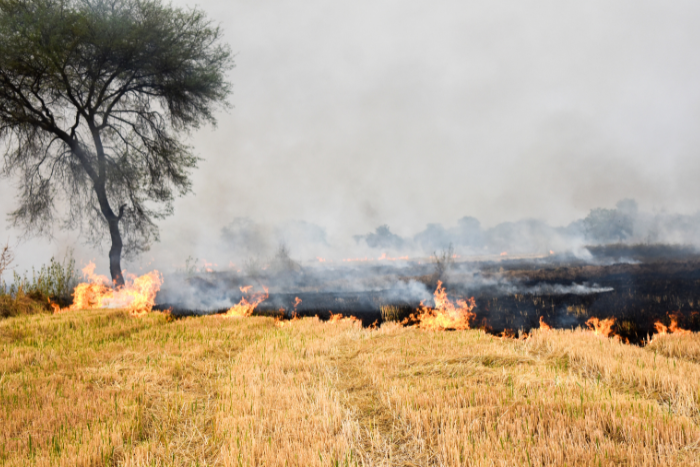Reduction in fire incidents in Punjab and Haryana yields promising results, but Delhi’s air health still faces seasonal challenges, the report finds
A new report has found that from 2019 to 2023, Haryana and Punjab have recorded fluctuations in fire incidents, with notable reductions in 2022 and 2023. However, despite the decline, Delhi’s air health was significantly impacted by these fire incidents.
The report by Climate Trends said that on days without fires, the city’s AQI averaged 175 (“Moderate”). But, given the fluctuations in fires, during the same stubble burning season, AQI increased to 233 (“Poor”). On days when fires exceeded climatological averages, AQI spiked to 337 (“Very Poor”).
Both states are categorised as important stubble burning regions. The air quality in Delhi has been significantly impacted by these fire occurrences, especially in the post-monsoon season. The results showed encouraging declines in the number of fires and continued difficulties in enhancing Delhi’s air quality.
Stubble burning on decline
The report found that the number of fires in Haryana decreased from 14,122 in 2019 to 7,959 in 2023, with September through December seeing the highest fire activity. There were notable declines in fire activity in districts Karnal and Kaithal, with declines of almost 86% and 78%, respectively.
Similar patterns were seen in Punjab, where fires peaked in 2020 at 95,048 and then declined to 52,722 in 2023. However, the post-monsoon season is still the most fire-prone time of year. Significant fire count reductions of up to 71% were noted in districts such as Gurdaspur and Muktsar. Districts like Bathinda and Faridkot showed moderate declines, with declines ranging from 22% to 45%. Minimal declines were observed in certain districts, such as Amritsar and Sangrur.
Experts said that persuasive communication, custom hired machineries and appropriate technological options have provided a boost to effective management of stubble burning.
“There is increasing awareness and farmers’ engagement in stubble burning management through an integrated approach of using short duration paddy varieties, on farm management with appropriate farm machineries to facilitate incorporation of straw in soil, mulching and preparation of feed blocks; application of microbial decomposers, as well as making alternative uses like supplying residues to power plants”, said Dr RN Padaria, joint director – extension, Indian Agriculture Research Institute (IARI).
However, some districts in Haryana like Gurgaon, Mewat and Jhajjhar showed notable rises in fire incidents. In Punjab, too, a few places like Sahibzada Ajit Singh Nagar experienced slight increases in fire counts.
Impact on Delhi’s air health
The report found that fire incidents in Punjab and Haryana contributed to a 103-unit increase in Delhi’s AQI, underscoring the urgent need for coordinated fire management and air quality interventions across states.
The data revealed a distinct seasonal pattern in fire activity, with the period from September to December consistently experiencing more fires than the earlier part of the year.
The findings emphasised the need for sustained fire management strategies and cross-state collaboration between Punjab, Haryana, and Delhi to mitigate the effects of stubble burning on air quality.
Dr Sagnik Dey, Professor, Centre for Atmospheric Sciences, IIT Delhi, pointed out that “while the farm fires have seen a dip in numbers, we must also focus on the other sources that contribute to Delhi’s poor air all year round.”
While reductions in fire incidents represent a positive trend, the report said that the seasonal peaks in air pollution require more robust interventions, such as improved agricultural practices, enhanced satellite monitoring, and stricter enforcement of fire-prevention measures. The report called for measures aimed at reducing stubble burning and improving public awareness, as well as investment in cleaner agricultural technologies.
About The Author
You may also like
Parents, Activists Protests at India Gate as Air Turns Toxic
Top court allows ‘green firecrackers’ in Delhi on Diwali with conditions
CPCB should help industry meet green norms: Environment Minister
Noise pollution from trains hit surrounding homes, exceed limits by 85%
Delhi residents losing over 8 yrs of life due to polluted air

